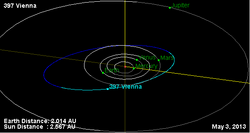Astronomy:397 Vienna
 Orbital diagram | |
| Discovery | |
|---|---|
| Discovered by | Auguste Charlois |
| Discovery date | 19 December 1894 |
| Designations | |
| (397) Vienna | |
| Pronunciation | /viˈɛnə/[1] |
| Named after | Vienna |
| 1894 BM | |
| Minor planet category | Main belt |
| Orbital characteristics[2] | |
| Epoch 31 July 2016 (JD 2457600.5) | |
| Uncertainty parameter 0 | |
| Observation arc | 117.45 yr (42,900 d) |
| |{{{apsis}}}|helion}} | 3.28657 astronomical unit|AU (491.664 Gm) |
| |{{{apsis}}}|helion}} | 1.98686 AU (297.230 Gm) |
| 2.63671 AU (394.446 Gm) | |
| Eccentricity | 0.24646 |
| Orbital period | 4.28 yr (1,563.8 d) |
| Mean anomaly | 202.358° |
| Mean motion | 0° 13m 48.731s / day |
| Inclination | 12.8534° |
| Longitude of ascending node | 227.935° |
| 139.975° | |
| Physical characteristics | |
| Dimensions | 49.032±1.055 km |
| Rotation period | 15.48 h (0.645 d) |
| Geometric albedo | 0.1776±0.015 |
| Absolute magnitude (H) | 9.31 |
Vienna (minor planet designation: 397 Vienna) is a typical Main belt asteroid. It was discovered by French astronomer Auguste Charlois on 19 December 1894 in Nice, and was most likely named after the city of Vienna, Austria.[3] This object is orbiting the Sun at a distance of 2.64 astronomical unit|AU with an orbital eccentricity (ovalness) of 0.246 and a period of 4.28 yr. The orbital plane is inclined at an angle of 12.85° to the ecliptic.[2]
Photometric observations from multiple sites during 2017 were combined to produce an irregular light curve showing a rotation period of 15.461±0.001 h with a luminosity amplitude of 0.16±0.02 in magnitude. This result is consistent with previous measurements.[4] The Tholen spectral type of this object is S and the SMASSII spectral type is K. Although the 'S' class suggests a stony composition, the latter class is consistent with carbonaceous chondrite meteorites.[5] Infrared observations from NEOWISE indicate a diameter of 49 km.[2]
References
- ↑ "Vienna". Vienna. Oxford University Press. http://www.lexico.com/definition/Vienna.
- ↑ 2.0 2.1 2.2 Yeomans, Donald K. (2007-05-02). "397 Vienna (1894 BM)". JPL Small-Body Database Browser. https://ssd.jpl.nasa.gov/sbdb.cgi?sstr=397.
- ↑ Schmadel, Lutz (2003). Dictionary of minor planet names. 1. Springer. p. 48. ISBN 9783540002383. https://books.google.com/books?id=VoJ5nUyIzCsC&pg=PA48.
- ↑ Pilcher, Frederick et al. (October 2017). "Rotation Period Determination for 397 Vienna". Bulletin of the Minor Planets Section of the Association of Lunar and Planetary Observers 44 (4): 316. Bibcode: 2017MPBu...44..316P.
- ↑ Clark, Beth Ellen et al. (July 2009). "Spectroscopy of K-complex asteroids: Parent bodies of carbonaceous meteorites?". Icarus 202 (1): 119–133. doi:10.1016/j.icarus.2009.02.027. Bibcode: 2009Icar..202..119C.
External links
- 397 Vienna at AstDyS-2, Asteroids—Dynamic Site
- 397 Vienna at the JPL Small-Body Database
 |

